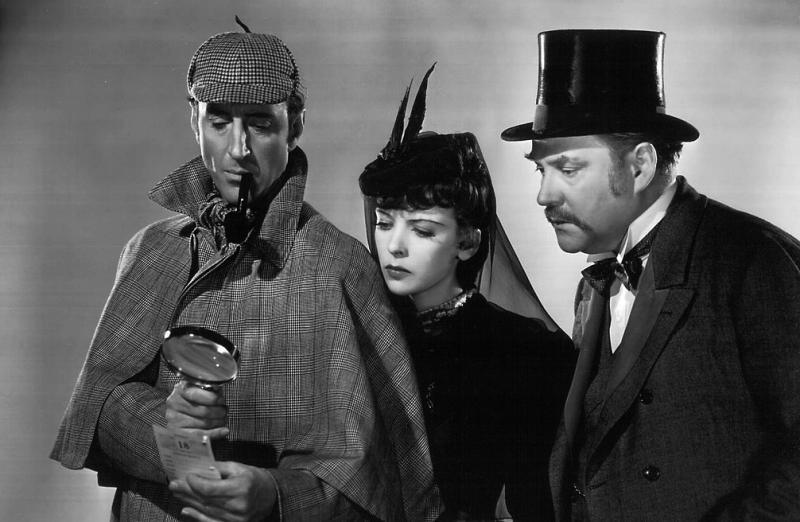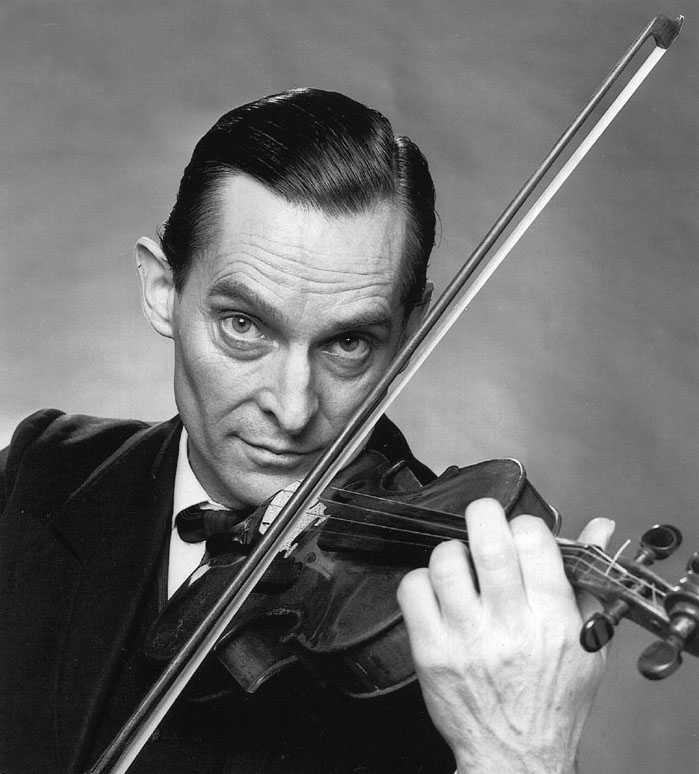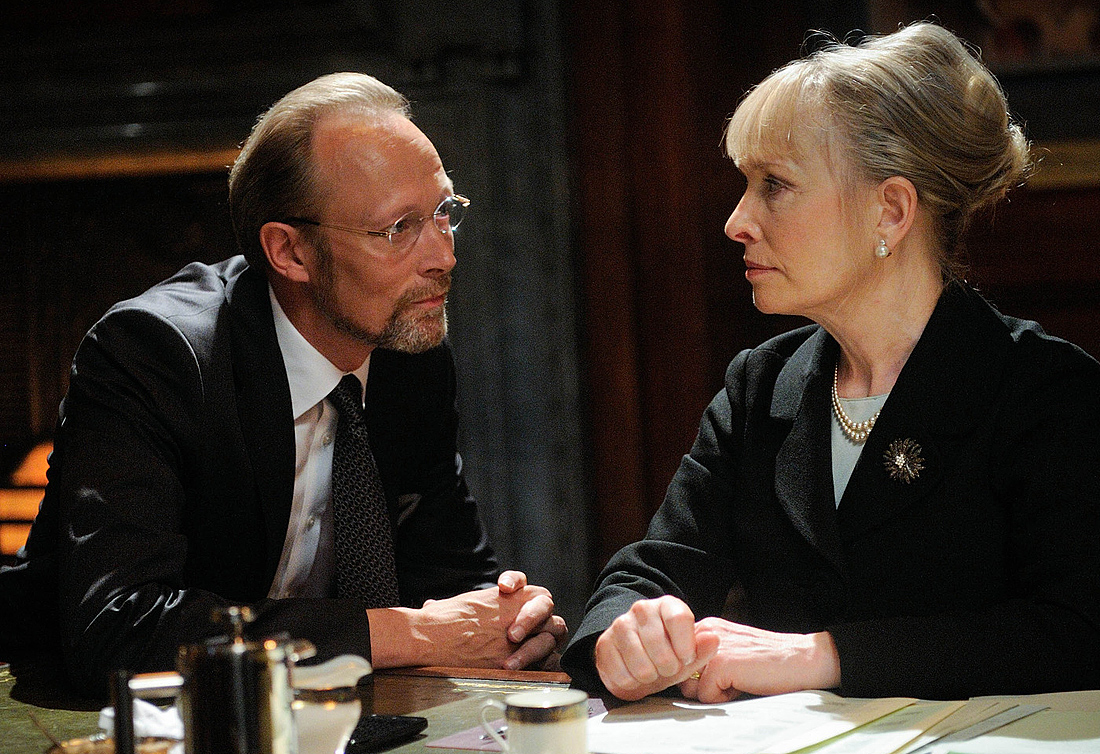Timeshift - How to Be Sherlock Holmes, BBC Four / Sherlock, BBC One | reviews, news & interviews
Timeshift - How to Be Sherlock Holmes, BBC Four / Sherlock, BBC One
Timeshift - How to Be Sherlock Holmes, BBC Four / Sherlock, BBC One
A history of Holmes from silent screen to 21st century, and an unsatisfying 'Sherlock'

As Benedict Cumberbatch's Sherlock reached the end of its latest brief span, Timeshift [****] surveyed the history of dramatic interpretations of Baker Street's finest with a wry eye, in a narrative sprinkled with nutritious facts and anecdotes.
Aided by zesty interviews with Christopher Lee, Tim Pigott-Smith, PD James and more, and pinned together by an outrageously fruity narration from Peter Wyngarde, what the film emphasised above all was the marvellous elasticity of Arthur Conan Doyle's creation, and the way that something about Holmes has left him equipped for perpetual reinvention down the decades. The traditional package - deerstalker, pipe, cape, violin and aquiline profile, as depicted in Sidney Paget's original illustrations in the Strand Magazine - still survives intact despite the popularity of recent updates like the Cumberbatch version or the Robert Downey/Guy Ritchie cartoonification. Holmes is the past, present and future Great Detective.
 It was in 1899 that the American actor William Gillette first brought Holmes to the stage. Gillette also starred in Sherl's first film incarnation in 1916, but that has been lost, and it's the string of silent pictures starring British actor Eille Norwood that stand as the earliest sightings of Holmes on screen. The ante was upped big time when Hollywood selected Basil Rathbone to portray the insuperable sleuth, who not only seemed to be Paget's drawings brought to life, but brought an air of brusque authority and splendid actorly diction. He was "very smooth and cool, sort of a Bond figure," as Cumberbatch put it.
It was in 1899 that the American actor William Gillette first brought Holmes to the stage. Gillette also starred in Sherl's first film incarnation in 1916, but that has been lost, and it's the string of silent pictures starring British actor Eille Norwood that stand as the earliest sightings of Holmes on screen. The ante was upped big time when Hollywood selected Basil Rathbone to portray the insuperable sleuth, who not only seemed to be Paget's drawings brought to life, but brought an air of brusque authority and splendid actorly diction. He was "very smooth and cool, sort of a Bond figure," as Cumberbatch put it.
There were subsequent memorable performances by Peter Cushing, Douglas Wilmer, Nicol Williamson and (still an all-time favourite) Jeremy Brett (pictured above), while Billy Wilder's The Private Life of Sherlock Holmes, starring Robert Stephens and Colin Blakely, was acclaimed as "a masterpiece" by Mark Gatiss. However, it was the 1942 Basil Rathbone movie Sherlock Holmes and the Voice of Terror which had given Steven Moffat, Gatiss's co-conspirator, some cues for the third and final episode of BBC One's Sherlock, subtitled "His Last Vow" [***].
The Voice of Terror was an unabashed chunk of anti-Nazi propaganda, and ended with a Churchillian speech from Rathbone about "an east wind coming... such a wind as never blew on England yet." The ghost of this "east wind" hovered over the new episode like a lingering aroma from Mrs Hudson's kitchen - "the east wind is coming, Sherlock," warned Gatiss's Mycroft, while Sherlock advised that "the east wind takes us all in the end" and Watson brought up the rear with "there's an east wind coming."
 However, this invocation of Sherlock Past felt more like a cry for help than a bold stride into the future, and did little to eradicate the creeping sense that this episode amounted to five characters in search of a story. Having hailed the Bollinger-like effervescence of the opening episode, I found myself rowing backwards here as this final one proceeded in circles, or sometimes went sideways, but couldn't get to the point. The defining moment came when Sherlock was shot. The scene was stretched out into a fatuous multi-angled mini-opera that did little more than fill some running time.
However, this invocation of Sherlock Past felt more like a cry for help than a bold stride into the future, and did little to eradicate the creeping sense that this episode amounted to five characters in search of a story. Having hailed the Bollinger-like effervescence of the opening episode, I found myself rowing backwards here as this final one proceeded in circles, or sometimes went sideways, but couldn't get to the point. The defining moment came when Sherlock was shot. The scene was stretched out into a fatuous multi-angled mini-opera that did little more than fill some running time.
Nominally, "His Last Vow" was the story of how Holmes proposed to thwart the blackmail scheme of the sinister newspaper tycoon Charles Augustus Magnusson, though the notion of a "newspaper tycoon" suddenly seems far more antiquated than deerstalker hats or hansom cabs. Though he wasn't given much rope, Lars Mikkelsen was able to imbue Magnusson with a brain-jangling aura of distilled threat, especially in the moment when he leaned over his victim Lady Smallwood (Lindsay Duncan, pictured above with Mikkelsen) and lasciviously licked her face. However, his vaunted super-vault containing the murky secrets of everybody in the world turned out to be the planet's dampest squib - there was no vault, he could just remember everything - and all the potential of Mikkelsen's character was lazily squandered. It would be the crime of the century if Sherlock degenerated into a Doctor Who-style orgy of gimmickry.
Share this article
The future of Arts Journalism
You can stop theartsdesk.com closing!
We urgently need financing to survive. Our fundraising drive has thus far raised £49,000 but we need to reach £100,000 or we will be forced to close. Please contribute here: https://gofund.me/c3f6033d
And if you can forward this information to anyone who might assist, we’d be grateful.

Subscribe to theartsdesk.com
Thank you for continuing to read our work on theartsdesk.com. For unlimited access to every article in its entirety, including our archive of more than 15,000 pieces, we're asking for £5 per month or £40 per year. We feel it's a very good deal, and hope you do too.
To take a subscription now simply click here.
And if you're looking for that extra gift for a friend or family member, why not treat them to a theartsdesk.com gift subscription?
more TV
 Mr Scorsese, Apple TV review - perfectly pitched documentary series with fascinating insights
Rebecca Miller musters a stellar roster of articulate talking heads for this thorough portrait
Mr Scorsese, Apple TV review - perfectly pitched documentary series with fascinating insights
Rebecca Miller musters a stellar roster of articulate talking heads for this thorough portrait
 Down Cemetery Road, Apple TV review - wit, grit and a twisty plot, plus Emma Thompson on top form
Mick Herron's female private investigator gets a stellar adaptation
Down Cemetery Road, Apple TV review - wit, grit and a twisty plot, plus Emma Thompson on top form
Mick Herron's female private investigator gets a stellar adaptation
 theartsdesk Q&A: director Stefano Sollima on the relevance of true crime story 'The Monster of Florence'
The director of hit TV series 'Gomorrah' examines another dark dimension of Italian culture
theartsdesk Q&A: director Stefano Sollima on the relevance of true crime story 'The Monster of Florence'
The director of hit TV series 'Gomorrah' examines another dark dimension of Italian culture
 The Monster of Florence, Netflix review - dramatisation of notorious Italian serial killer mystery
Director Stefano Sollima's four-parter makes gruelling viewing
The Monster of Florence, Netflix review - dramatisation of notorious Italian serial killer mystery
Director Stefano Sollima's four-parter makes gruelling viewing
 The Diplomat, Season 3, Netflix review - Ambassador Kate Wyler becomes America's Second Lady
Soapy transatlantic political drama keeps the Special Relationship alive
The Diplomat, Season 3, Netflix review - Ambassador Kate Wyler becomes America's Second Lady
Soapy transatlantic political drama keeps the Special Relationship alive
 The Perfect Neighbor, Netflix review - Florida found-footage documentary is a harrowing watch
Sundance winner chronicles a death that should have been prevented
The Perfect Neighbor, Netflix review - Florida found-footage documentary is a harrowing watch
Sundance winner chronicles a death that should have been prevented
 Murder Before Evensong, Acorn TV review - death comes to the picturesque village of Champton
The Rev Richard Coles's sleuthing cleric hits the screen
Murder Before Evensong, Acorn TV review - death comes to the picturesque village of Champton
The Rev Richard Coles's sleuthing cleric hits the screen
 Black Rabbit, Netflix review - grime and punishment in New York City
Jude Law and Jason Bateman tread the thin line between love and hate
Black Rabbit, Netflix review - grime and punishment in New York City
Jude Law and Jason Bateman tread the thin line between love and hate
 The Hack, ITV review - plodding anatomy of twin UK scandals
Jack Thorne's skill can't disguise the bagginess of his double-headed material
The Hack, ITV review - plodding anatomy of twin UK scandals
Jack Thorne's skill can't disguise the bagginess of his double-headed material
 Slow Horses, Series 5, Apple TV+ review - terror, trauma and impeccable comic timing
Jackson Lamb's band of MI5 misfits continues to fascinate and amuse
Slow Horses, Series 5, Apple TV+ review - terror, trauma and impeccable comic timing
Jackson Lamb's band of MI5 misfits continues to fascinate and amuse
 Coldwater, ITV1 review - horror and black comedy in the Highlands
Superb cast lights up David Ireland's cunning thriller
Coldwater, ITV1 review - horror and black comedy in the Highlands
Superb cast lights up David Ireland's cunning thriller
 Blu-ray: The Sweeney - Series One
Influential and entertaining 1970s police drama, handsomely restored
Blu-ray: The Sweeney - Series One
Influential and entertaining 1970s police drama, handsomely restored

Add comment